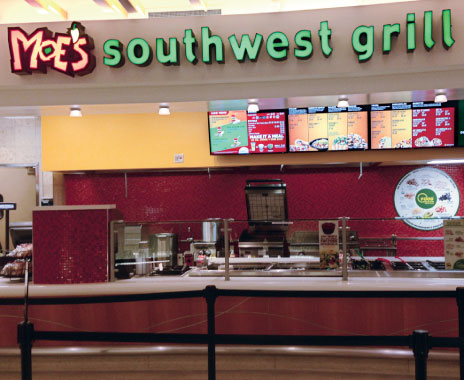An airport location offers quick serves domestic and international brand exposure, sound growth opportunities, and increased profits. But, like many other nontraditional venues, airports require restaurants to wrangle space restrictions, difficult logistics, and menu limitations.
“You really have to understand what you’re getting into,” says Anthony Joseph, president of Atlanta-based Concessions International (CI), a food and beverage concessionaire with operations in eight airports.
Street locations have four to five times the square footage of airport locations, he says, and some kitchens are less than half the size of those in street units, even though they may do twice the volume at times.
Even for the most basic quick-service operation, the use of tools and equipment is different. At Seattle-Tacoma International Airport, due to security rules, especially beyond checkpoints, every concessionaire is required to maintain a formal log of knives and other sharp objects. This process is monitored by airport security, and audits are conducted on a regular basis. On most of Atlanta Hartsfield-Jackson International Airport’s concourses, only electric ranges are offered, instead of gas ranges.
One of the biggest obstacles in airport units is the internal distribution that gets products from the vendor to the restaurant. Airports have off-site commissaries that store food, and those commissaries can sometimes be a couple miles off airport property. At the commissary, all products are delivered, separated, and transported to the restaurant within the airport.
“The frozen, cold, and dry storage within each airport restaurant is minuscule,” says Paul Damico, president of Mexican chain Moe’s Southwest Grill, which recently opened a unit in Florida’s Orlando International Airport. “Most of the square footage in airport restaurants is allotted to the front of the house to maximize the speed capacity, so the whole issue of getting food into the airport is a logistical challenge.”
Due to the restrictions on storage space, deliveries are limited. Damico paints a picture of an airport terminal with 30 restaurants in it: Each of those individual restaurants will only receive one delivery a day that must be enough to support the business for that day.
Because airports never close, concession locations are required to be open to the traveling public seven days a week, year-round, especially in the event of flight delays and bad weather. In these instances, all concession locations in the areas of the airport impacted by delays must remain open to accommodate affected passengers. Damico says this poses a unique logistics challenge because of the unpredictable fluctuation of traffic and limited access to the commissary.
“If your restaurant can hold enough food to generate, say, $5,000 worth of business that day, but all of a sudden there’s a snow storm and tens of thousands of people are delayed, and now you’re going to do $15,000 worth of business that day, it becomes a challenge to get food from the commissary,” he says.
The extreme limitations on storage, kitchen, and prep space, meanwhile, force many airport locations modify or scale menus to support limited storage and supply areas.
Joseph says his company’s corporate chef, Jeff Call, works closely on every project to analyze and develop the menu with brand partners. For example, Call worked with CI client Fresh to Order last year when the brand sought to open in Hartsfield-Jackson. The chain’s airport menu features its most popular quick items: gourmet sandwiches, salads, and soups, all prepared on-site.
Damico says Moe’s had to eliminate the kids’ menu in some locations, but otherwise kept all items available. He says the brand’s biggest challenge in the airport environment is the salsa bar. In a traditional Moe’s, the free salsa bar stands out in the dining room.
“We find ourselves having to pre-portion our salsas and serve them from behind the line so the guests don’t get to experience the free salsa bar,” Damico says.
Chris Burr, director of nontraditional development at Dunkin’ Brands, says his team always tries to offer Dunkin’s full menu, but often must limit certain portions.
There are also instances when an airport will limit a restaurant’s menu. Burr says airport stipulations in Denver International Airport do not allow food to be cooked on airport property. As a result, Dunkin’ eliminated breakfast sandwiches at that location.
Staffing also can be difficult, as airport restaurant employees must go through extensive TSA-approved background checks.
Despite these specific challenges and higher rents, the added hassles of an airport location are still worthwhile for some concepts because of two main reasons, Damico says. The first is revenue; Damico says the potential revenue can be two to three times the sales volume of a traditional unit. The second is exposure. For example, Hartsfield-Jackson, the world’s busiest airport, averages more than 250,000 passengers a day, according to its website.
“Airport locations put your brand where your customers are,” Burr says. “It gives your brand exposure to new customers who may not have your brand where they live, and re-exposes the brand to lax users and gives them an opportunity to re-engage with the brand.”







